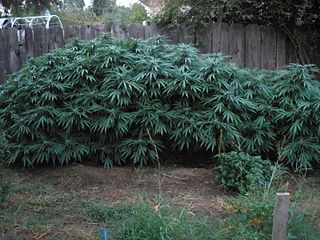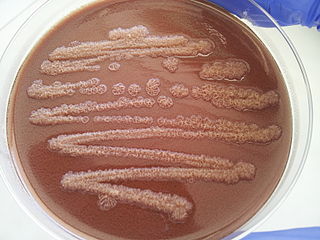
Pseudomonas is a genus of Gram-negative, Gammaproteobacteria, belonging to the family Pseudomonadaceae and containing 191 validly described species. The members of the genus demonstrate a great deal of metabolic diversity and consequently are able to colonize a wide range of niches. Their ease of culture in vitro and availability of an increasing number of Pseudomonas strain genome sequences has made the genus an excellent focus for scientific research; the best studied species include P. aeruginosa in its role as an opportunistic human pathogen, the plant pathogen P. syringae, the soil bacterium P. putida, and the plant growth-promoting P. fluorescens, P. lini, P. migulae, and P. graminis.

Pseudomonas fluorescens is a common Gram-negative, rod-shaped bacterium. It belongs to the Pseudomonas genus; 16S rRNA analysis as well as phylogenomic analysis has placed P. fluorescens in the P. fluorescens group within the genus, to which it lends its name.
Pseudomonas putida is a Gram-negative, rod-shaped, saprotrophic soil bacterium.
In chemistry, a molecule experiences strain when its chemical structure undergoes some stress which raises its internal energy in comparison to a strain-free reference compound. The internal energy of a molecule consists of all the energy stored within it. A strained molecule has an additional amount of internal energy which an unstrained molecule does not. This extra internal energy, or strain energy, can be likened to a compressed spring. Much like a compressed spring must be held in place to prevent release of its potential energy, a molecule can be held in an energetically unfavorable conformation by the bonds within that molecule. Without the bonds holding the conformation in place, the strain energy would be released.

Cannabis indica is an annual plant in the family Cannabaceae. It is a putative species of the genus Cannabis. Whether it and Cannabis sativa are truly separate species is a matter of debate. The Cannabis indica plant is cultivated for many purposes; for example, the plant fibers can be converted into cloth. Cannabis indica produces large amounts of tetrahydrocannabinol (THC). The higher concentrations of THC provide euphoric and intoxicating effects making it popular for use both as a recreational and medicinal drug.

Pseudomonas aeruginosa is a common encapsulated, Gram-negative, rod-shaped bacterium that can cause disease in plants and animals, including humans. A species of considerable medical importance, P. aeruginosa is a multidrug resistant pathogen recognized for its ubiquity, its intrinsically advanced antibiotic resistance mechanisms, and its association with serious illnesses – hospital-acquired infections such as ventilator-associated pneumonia and various sepsis syndromes.

Pseudomonas syringae is a rod-shaped, Gram-negative bacterium with polar flagella. As a plant pathogen, it can infect a wide range of species, and exists as over 50 different pathovars, all of which are available to researchers from international culture collections such as the NCPPB, ICMP, and others.
Pseudomonas moraviensis is a Gram-negative soil bacterium. It is named after Moravia, the region of the Czech Republic where it was first isolated. The type strain is CCM 7280T.
Pseudomonas palleroniana is a Gram-negative bacterium that infects rice. The type strain is CFBP 4389.
Pseudomonas trivialis is a fluorescent, Gram-negative bacterium isolated from the phyllosphere of grasses. The type strain is DSM 14937.
Pseudomonas poae is a fluorescent, Gram-negative bacterium isolated from the phyllosphere of grasses. The type strain is DSM 14936.
Pseudomonas congelans is a fluorescent, Gram-negative bacterium isolated from the phyllosphere of grasses. The type strain is DSM 14939.
Pseudomonas koreensis is a Gram-negative, non-spore-forming, motile, multiple polar flagellated, yellow-white, rod bacterium isolated from farming soil in Korea. The type strain is LMG 21318.
Pseudomonas umsongensis is a Gram-negative, non-spore-forming, motile, single polar-flagellated, yellow-white, rod-shaped bacterium isolated from the soil in the Umsong region of Korea. The type strain is LMG 21317.
Pseudomonas costantinii is a Gram-negative bacterium that causes brown blotch disease in cultivated mushrooms. It demonstrates hemolytic activity. The type strain is CFBP 5705.

Pseudomonas stutzeri is a Gram-negative soil bacterium that is motile, has a single polar flagellum, and is classified as bacillus, or rod-shaped. While this bacterium was first isolated from human spinal fluid, it has since been found in many different environments due to its various characteristics and metabolic capabilities. P. stutzeri is an opportunistic pathogen in clinical settings, although infections are rare. Based on 16S rRNA analysis, this bacterium has been placed in the P. stutzeri group, to which it lends its name.

Cefsulodin is a third-generation cephalosporin antibiotic that is active against Pseudomonas aeruginosa and was discovered by Takeda Pharmaceutical Company in 1977.

Cannabis strains are either pure or hybrid varieties of the plant genus Cannabis, which encompasses the species C. sativa, C. indica, and C. ruderalis.
3-Succinoylsemialdehyde-pyridine dehydrogenase (EC 1.2.1.83) is an enzyme with systematic name 4-oxo-4-(pyridin-3-yl)butanal:NADP+ oxidoreductase. This enzyme catalyses the following chemical reaction







